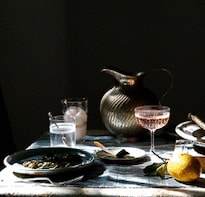My last bite would be something that I had eaten at the beginning of my life, too. I like the idea of things coming full circle. In Lebanon, there's no notion of nursery food. Kids eat with their parents - they just have what their mother has cooked for the whole family.As a child, I always loved mehshi silq bil-zeyt. It's Swiss chard stuffed with rice, tomatoes, herbs and spices. The dish is silky and luscious with a wonderful mouth-feel; the textures in the stuffing balance perfectly. Stuffed vegetables are very common across the Levant. Swiss chard always seems extra-special, because it is so seasonal.If I could, I'd go back in time and source all the ingredients from Jamil. He worked for my family when I was a kid in Lebanon and grew produce in his back garden. You could, without a doubt, taste the love and care with which his vegetables were grown. I haven't had better; sadly he's no longer with us.I like the idea of drinking something luxurious and elegant to accompany simple food. Hmmm, Cristal Rose champagne. That goes with everything, doesn't it? (And if I'm being honest, I might sneak in a few mouthfuls of foie gras and caviar, too.)
Advertisement
Mehshi silq bil-zeyt (stuffed swiss chard)
In the south, they leave out the lemon juice and olive oil and increase the amount of sumac to 3 tbsp. I never tried it this way but I can't imagine it to be an improvement.Advertisement
For the stuffing
150g white short-grain rice
300g firm red tomatoes, diced into 5mm cubes
½ bunch spring onions, about 50g, trimmed and thinly sliced
½ bunch flat parsley, about 100g, washed, dried, most of the stalks cut off, chopped
¼ bunch mint, about 50g, leaves only, chopped
2 tbsp sumac
¼ tsp ground cinnamon
½ tsp ground allspice
¼ tsp finely ground black pepper
A pinch of salt
Juice of 1 large lemon, or to taste
150ml extra virgin olive oilFor the swiss chard
1kg swiss chard
1 large ripe tomato, sliced
Salt1 To make the stuffing, first rinse the rice under cold water. Drain thoroughly and put in a mixing bowl. Add the rest of the stuffing ingredients - the stuffing should look like a salad. Taste and adjust the seasoning if necessary.2 To prepare the chard, cut the leaves in large enough pieces that you can roll them around the stuffing at least four times - otherwise they may become too fragile to handle and they may break during cooking or serving. Ideally, each leaf should divide into three, one piece from the top and two from either side of the stalk. You are bound to have some damaged leaves, so first line the bottom of a large casserole with the damaged leaves, thin stalks and tomato slices.
Advertisement
Advertisement
For the latest food news, health tips and recipes, like us on Facebook or follow us on Twitter and YouTube.
Advertisement
